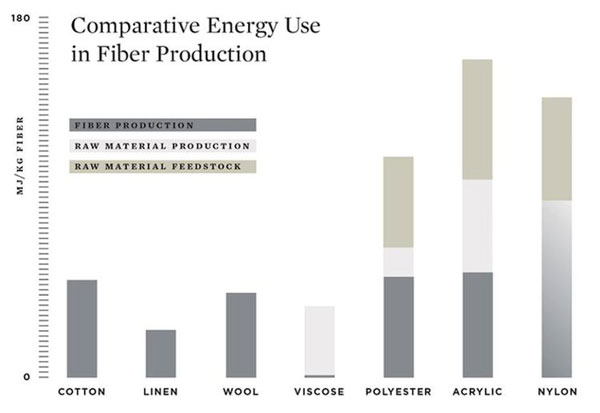[Source: Forbes] As the COP21 climate change talks are underway in Paris this week, it’s nice to see real progress on fronts rarely discussed. Lots of industries other than energy production are important sources of greenhouse gas emissions – agriculture, iron and metal smelting, cement production, waste treatment and … the fashion industry.
The apparel industry accounts for 10% of global carbon emissions and remains the second largest industrial polluter, second only to oil.
This shouldn’t be surprising since it’s a $3 trillion global industry. The apparel market in the United States tops the world, contributing close to a third of the global total.
Some innovative fashionistas are looking seriously at the industry’s role in environmental pollution and climate change.
Zady is one of these new sustainable fashion brands and is a leading voice of the slow fashion movement that has created online resources for consumers to learn how their clothing decisions can have a large impact on the environment.
And they present some amazing facts:
- Nearly 70 million barrels of oil are used each year to make the world’s polyester fiber, which is now the most commonly used fiber in our clothing. But it takes more than 200 years to decompose.
- More than 150 billion garments are produced annually, enough to provide 20 new garments to every person on the planet, every year.
- Americans throw away about 70 lbs of clothing per person every year.
- Fast fashion garments, which we wear less than 5 times and keep for 35 days, produce over 400% more carbon emissions per item per year than garments worn 50 times and kept for a full year.
- Cheap synthetic fibers also emit gasses like N2O, which is 300 times more damaging than CO2.
- Over 70 million trees are logged every year and turned into fabrics like rayon, viscose, modal and lyocell.
- Cotton is the world’s single largest pesticide-consuming crop, using 24% of all insecticides and 11% of all pesticides globally, adversely affecting soil and water.
- Plastic microfibers shed from our synthetic clothing into the water supply account for 85% of the human-made material found along ocean shores, threatening marine wildlife and ending up in our food supply.
- The fashion industry is the second biggest polluter of freshwater resources on the planet.
- A quarter of the chemicals produced in the world are used in textiles.

These latter environmental effects like water pollution go beyond just the climate issue and are also a major focus at COP21. In fact, just yesterday in Paris a broad coalition of nations, river basin organizations, businesses and civil societies announced the creation of “the international Paris Pact on Water and Climate Change Adaptation to make water systems – the very foundation of sustainable human development – more resilient to climate impacts.”
The slow fashion movement should be a big part of this Pact.
But the apparel industry’s impact extends to more than just the environment. Social and economic issues are front and center as well. In fact, slow fashion began to surge after the Rana Plaza disaster in Bangladesh in 2013. Over 1,100 people were killed when the building they were working in collapsed. The workers were making cheap clothing for the West as fast as possible in conditions where health and safety just didn’t matter.
Consumers didn’t know, or care, how their two-dollar tube socks were being made. But this is changing.
Zady CEO and cofounder Maxine Bédat describes the role consumers can play in making sustainable fashion choices as well as the changes the industry can take to help meet new sustainability goals. “The clothing we choose to wear everyday has an enormous impact on the planet and its people. Our clothing can either continue to be a major part of the problem, or it can be an enormous part of getting our planet on track. The choice is ultimately ours. We can vote at the ballot box for strong climate measures and vote at the cash register for clean clothes.”
Similar to the reasoned response to “fast food” when we began caring about where the beef came from and how many chemicals were used to prepare it, the slow fashion movement is about choices.
Take linen.
Linen is a natural material woven from the fibers of the flax plant. Flax belongs to the family of bast fibers, which also includes hemp and jute, obtained from the inner bark of the stalk of certain plants.
White, lightweight and durable, linen is one of the world’s oldest textiles, dating back to about 7,000 BC. When cotton production became mechanized in the 19th century, hand-made linen declined, even though it was a superior material that lasts for many years, is gentle on the environment and requires the least energy, water, pesticides or other resources to produce relative to other fibers like cotton or polyester (see figure).
So the consumer needs to actively choose materials like linen. And wool. They may be more expensive up front, but will more than pay for themselves by lasting years longer than other materials, and these new brands just feel so much better on your body.
Looking good, feeling good and doing good are no longer mutually exclusive. And it’s all the fashion.
Dr. James Conca is an expert on energy, nuclear and dirty bombs, a planetary geologist, and a professional speaker. Follow him on Twitter @jimconca and see his book at Amazon.com.
Source: Forbes
December 3, 2015


